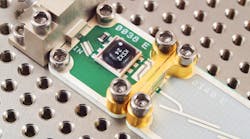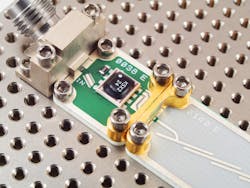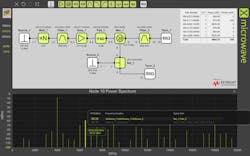Download this article as a .PDF
Mini-Circuits, a long trusted supplier of RF/microwave components, is teaming up with X-Microwave to offer the company’s components on X-Microwave’s X-MWblock drop-in module format. By employing the modular, solderless drop-in system along with companion hardware, software, and simulation tools, designers using Mini-Circuits components can speed and simplify the process of evaluating components working together in subsystems and subassemblies, such as receivers or transmitters. Furthermore, they can quickly redesign and optimize their assemblies as needed thanks to the flexible, modular nature of the X-Microwave approach.
Over 400 X-MWblocks are initially available for Mini-Circuits components, including filters, amplifiers, mixers, multipliers, limiters, couplers, switches, power dividers/combiners, and attenuators, with more planned. Each component for use in the X-MWblock format is supported by a computer simulation model based on measurements, enabling online computer simulations of multiple components working together in a signal chain.
The X-MWsystem drop-in prototyping approach already features components from Analog Devices, Custom MMIC, and others. Using these drop-in X-MWblock components as part of an assembly or subsystem makes it possible to evaluate the interactions among the components, such as reflections or mismatches, in software as well as in hardware.
Users of this design approach (Fig. 1) gain access to X-Microwave’s test probes and prototyping systems to evaluate the performance of an assembly. All assembly accessories are included in the X-MWsystem, along with standard machined housings for connectorized versions of the X-MWblocks.
End-launch connectors for the X-MWblocks provide low-loss, low-reflection performance to 50 GHz. Called X-MWendlaunch connectors within the X-MWsystem, they employ a solderless bolt-on design.
From Blocks to Prototyping Stations
The X-MWsystem essentially adapts components of many different shapes and sizes to a universal package known as an X-MWblock. Adapting different types of components from different suppliers to common launch geometries and mounting arrangements helps simplify integration and speed assembly of multi-function subsystems.
X-MWblocks can be assembled on a prototyping station known as an X-MWprotostation, which consists of a stainless-steel grid plate with a standard hole pattern to simplify component placement. Since the entire design approach is modular, arbitrary enclosures can be formed around the X-MWprotostations using modular wall and lid pieces to emulate cavity effects at the prototype phase.
Assembled X-MWprotostations can be connected for testing using X-MWcables and custom X-MWprobes. The RF probes consist of a 1.85- or 2.92-mm female coaxial connector capable of operating to 67 GHz and 50 GHz, respectively. The probes can connect to any X-MWblock as a ground-signal-ground (GSG) probe.
By using this universal connector and packaging approach, the X-MWsystem makes it possible to eliminate the need for custom evaluation boards while adapting to other components with different connector types. The X-MWblocks and the X-MWprotostation function as the evaluation boards and then, once properly tested, as the production components.
Components available as X-MWblocks are well supported by models based on S-parameter measurements for linear devices and X-parameter measurements for nonlinear devices. For those without ready access to a software simulator, X-Microwave even provides access to an online software simulator, the X-MWsimulator, with models for all components contained in a prototype assembly or subsystem available free of charge (Fig. 2). The software simulator is based on the Genesys Spectrasys simulation software from Keysight Technologies.
In support of physical designs, an online Mechanical Layout Tool (MLT) allows users to move two-dimensional (2D) component representations around a layout grid that serves as a form of map to configure actual components on a solderless prototyping plate for testing and design validation. The drop-in components can then be assembled in compatible production housings that support of a full drop-in approach to system design.
Mini-Circuits, P.O. Box 350166, Brooklyn, NY 11235-003; (718) 934-4500



